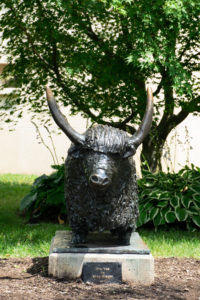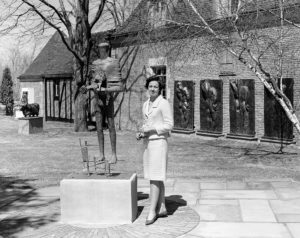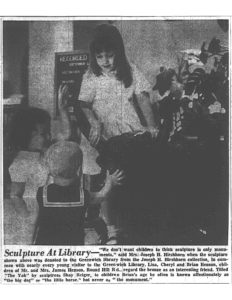Much like the New York Public Library has its two famed lions, Patience and Fortitude, guarding its doors, the Greenwich Library also has a familiar mascot. For more than 50 years, visitors to the Library have been charmed by one particular resident: our stout, bronze yak.
Today, the 2-and-a-half-foot-tall yak stands along the northern entrance walkway, greeting patrons coming in from the parking lot. It’s a favorite of children, who often pose for pictures or hop on its back like it’s one of those coin-operated kiddie rides from the past.
But how did this endearing mascot—one of an animal not even native to this continent, much less Connecticut—come to settle at Greenwich Library? As with many public art pieces, it was the product of creative energy, inspired placing, and a generous donation.

During the 1960s and early ‘70s, financier Joseph Hirshhorn was one of Greenwich’s most prominent residents. Hirshhorn, who made a fortune on Wall Street before the Depression and then again mining gold and uranium in the 1940-50s, had always spent lavishly on the arts. He acquired his first works at age 18: two etchings by the 16th-century German artist Albrecht Dürer, which he purchased for $75 each (or roughly $1800 each today).
Over the next several decades, Hirshhorn continued to collect paintings and sculptures, and he frequently socialized with and patronized living artists such as Edward Hopper, Stuart Davis, and Arshile Gorky. He was close friends with Willem de Kooning and helped finance the construction of his Long Island studio, and he was known to gallivant around Paris with Pablo Picasso and Man Ray. When Hirshhorn moved to Greenwich, he purchased Round Hill, a 23-room Norman chateau built on 22 acres—perfect for housing his collection of some 6000 paintings and sculptures. This growing treasury would one day become the foundation of the Smithsonian Institute’s Hirshhorn Museum and Sculpture Garden in Washington, D.C.
One artist Hirshhorn took an interest in was Greenwich Village-based Shay Rieger. While he owned a number of her abstract realism paintings, it was Rieger’s charming animal sculptures that really put her on the map.
Born and raised in New York City, Rieger began modeling animals in clay as a child. When she moved on to bronze, she’d spend hours at the Central Park Zoo sketching delicate cranes and owls as well as hulking hippos and elephants. According to a 1967 piece in the Greenwich Time, Rieger recalled that she was such a regular presence at the zoo that the live yak would recognize and greet her.

Rieger completed “The Yak” in 1960; it was purchased by Hirshhorn and displayed at his Round Hill estate. But Rieger had always wanted her pieces to invoke the opposite impulses of museum sculptures—what she called a “please touch” proclivity rather than “do not touch.” Hirshhorn and his wife, Olga Zatorsky, a Greenwich native whom he’d met after moving to the area, felt the same.
The couple donated “The Yak” to the Greenwich Library in 1965 with the hope that it would thrill young patrons the way it did the children in their neighborhood, such as Lisa, Cheryl, and Brian Henson, the children of famed Muppets creator Jim Henson, who lived down the street from the Hirshhorns and did visit the yak at its new Library home.

Two years later, when Rieger came to Greenwich Library to showcase a whole menagerie of animal statuary in the gallery, the newspaper recounted she “was delighted to find that the horns of the yak were assuming the soft, golden patina that can only be achieved by the polishing action of thousands of small hands.”
Now, more than 50 years since “The Yak” became a permanent fixture at the Library, several generations of children have gotten the chance to pet, ride, and converse with the beloved bronze.
ABOUT
Build your family tree, dive into the history of your historic home, and discover photos and articles of days gone past with the Library’s collection of 5,000 books, 800 Oral History transcripts, yearbooks, historical maps, vertical files, pamphlets, periodicals, and microfilm and microfiche. Plus, access resources like American Ancestors, AncestryLibrary, and more with a Library card. Learn more at greenwichlibrary.org/genealogy.
Get the latest about the Library’s History & Genealogy events and offerings sent to your email: greenwichlibrary.org/enews.
Questions? Contact:
Local History Librarian
(203) 622-7948
